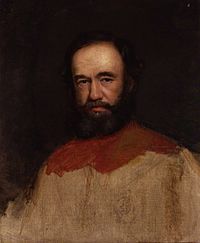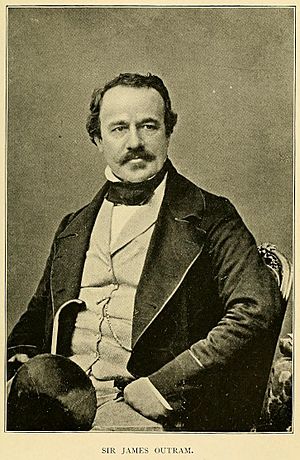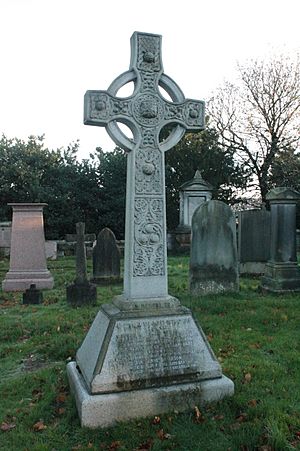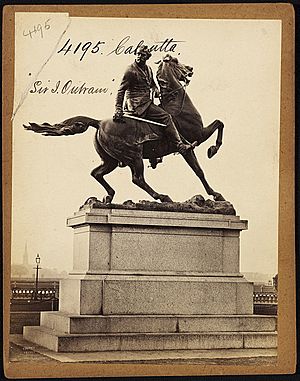Sir James Outram, 1st Baronet facts for kids
Quick facts for kids
James Outram
1st Bt., GCB, KCSI
|
|
|---|---|

Sir James Outram
|
|
| Nickname(s) | The Bayard of India |
| Born | 29 January 1803 Butterley, Derbyshire, England |
| Died | 11 March 1863 (aged 60) Pau, Pyrenees-Atlantiques, France |
| Buried | |
| Allegiance | |
| Service/ |
|
| Years of service | 1819–1860 |
| Rank | Lieutenant General |
| Battles/wars | First Anglo-Afghan War
|
| Awards | Knight Grand Cross of the Order of the Bath Knight Companion of the Order of the Star of India |
| Alma mater | Marischal College, University of Aberdeen |
| Other work | Resident Minister of Lucknow Chief Commissioner of Oudh |
Lieutenant-General Sir James Outram (born January 29, 1803 – died March 11, 1863) was a British general. He is famous for his role in the Indian Rebellion of 1857. People called him the "Bayard of India" because he was brave and honorable.
Contents
Early Life and Military Start
James Outram was born in Butterley, England. His father, Benjamin Outram, was an engineer. James's father died when he was young. In 1810, his mother moved the family to Scotland.
James went to Marischal College in Aberdeen in 1818. A year later, he joined the British East India Company's army. He quickly showed great energy. In 1820, he became an adjutant in a regiment in Poona, India. This early experience helped him a lot in his future career.
Working with the Bhils in Khandesh
In 1825, James Outram went to Khandesh. This area had thick forests and hills. He was tasked with training a special group of soldiers. These soldiers were from the Bhil tribe, who lived in the region.
Outram became very popular with the Bhils. He used their skills to stop crime and raids. The Bhils admired his amazing hunting abilities. He was known for his daring and close calls during hunts. Though he was often sick when he first arrived in India, he grew very strong. He became known for his "nerves of steel."
Adventures in Gujarat and Sindh
In 1835, Outram went to Gujarat. He worked there as a political agent. This meant he helped manage the area for the British.
When the First Anglo-Afghan War began in 1838, Outram joined the fight. He led attacks against Afghan tribes. He even captured an enemy flag before the city of Ghazni. This was a very brave act.
In 1839, he became a Major. He then worked in Sindh, another region in India. He disagreed with his boss, Sir Charles James Napier, about taking over Sindh. However, when war broke out, Outram bravely defended a British building in Hyderabad, Pakistan. He faced 8,000 Baluchi fighters. Sir Charles Napier called him the "Bayard of India."
After a short trip to England, Outram returned to India. He continued to serve in different parts of the country. He was known for speaking out against corruption.
Role in the Indian Rebellion of 1857
In 1854, Outram became the British representative in Lucknow. Two years later, he helped take control of Oudh province. He became its first chief commissioner.
In 1857, Outram was sent to lead an army against Persia in the Anglo-Persian War. He quickly defeated the Persian forces. Peace was made in March 1857. For his success, he received a high honor.
Soon after, he was called back to India. The Indian Rebellion of 1857 had begun. Outram was put in charge of British forces from Calcutta to Cawnpore. He also became the commissioner of Oudh again.
The British garrison in Lucknow was in danger. General Henry Havelock was trying to reach them. When Outram arrived with more soldiers, he made a remarkable decision. He admired Havelock's bravery. So, Outram stepped aside and let Havelock lead the mission to relieve Lucknow. Outram served as a volunteer under Havelock.
During the advance, Outram led a group of volunteer cavalry. He showed great courage in battles. He charged through heavy gunfire. The volunteer cavalry wanted to give him the Victoria Cross, a very high award. But Outram refused, saying he was not eligible as he was a general.
After Havelock rescued the Lucknow garrison, Outram took command again. He held the town until more British forces arrived. He then cleverly evacuated the residency, tricking the enemy. Later, during the second capture of Lucknow, Outram played a key role. He led attacks that helped secure the city. After this, he was promoted to lieutenant-general.
Later Life and Legacy
In February 1858, both houses of the British Parliament thanked Sir James Outram. He was also given the title of baronet and a yearly payment.
His health began to fail, so he returned to England in 1860. People raised money to honor him. Statues of him were built in London and Calcutta.
Sir James Outram died in Pau, France, on March 11, 1863. He was buried in Westminster Abbey in London. His grave has a special message: "The Bayard of India."
Family
James Outram was married to Margaret Clementine Anderson. She is buried in Dean Cemetery in Edinburgh, Scotland. Their son, Sir Francis Boyd Outram, is also buried there.
Places Named After Sir James Outram
Many places around the world are named after Sir James Outram. This shows his lasting impact.
- Autram Ghat is a mountain pass in Maharashtra, India.
- Outram Street in Perth, Australia, is named after him.
- Jamesabad, Pakistan, is a town named in his honor during British rule.
- Outram, Singapore is an area in Singapore, named after Outram Road. The nearby MRT station is Outram Park.
- Outram, New Zealand is a small town near Dunedin.
- Outram Road in Croydon, south London, is also named after him.
- The Outram Ghat in Kolkata, India, is a riverfront area.
- Outram Lines in Kingsway Camp, Delhi, India.
- Outram Road in Southsea, Hampshire, United Kingdom.
- Outram Hall in Auckland, New Zealand.
- Outram Street in Ripley, Derbyshire, United Kingdom, near his birthplace.
Outram in Fiction
Sir James Outram appears as a character in books and films:
- He is in the book Flashman in the Great Game by George MacDonald Fraser.
- Richard Attenborough played him in the 1977 film The Chess Players.





